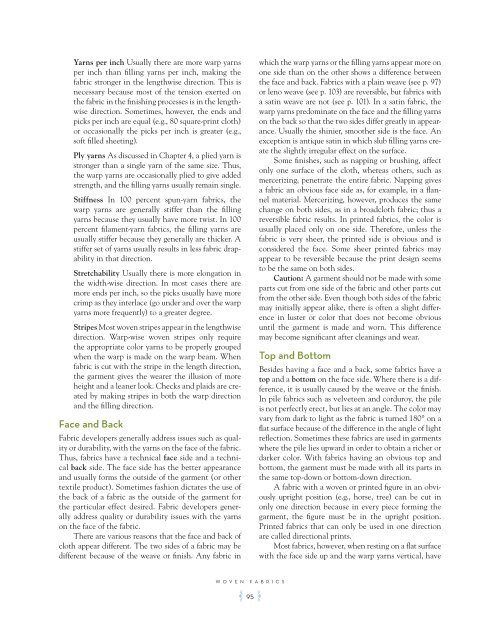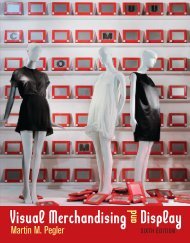Create successful ePaper yourself
Turn your PDF publications into a flip-book with our unique Google optimized e-Paper software.
Yarns per inch Usually there are more warp yarns<br />
per inch than filling yarns per inch, making the<br />
fabric stronger in the lengthwise direction. This is<br />
necessary because most of the tension exerted on<br />
the fabric in the finishing processes is in the lengthwise<br />
direction. Sometimes, however, the ends and<br />
picks per inch are equal (e.g., 80 square-print cloth)<br />
or occasionally the picks per inch is greater (e.g.,<br />
soft filled sheeting).<br />
Ply yarns As discussed in Chapter 4, a plied yarn is<br />
stronger than a single yarn of the same size. Thus,<br />
the warp yarns are occasionally plied to give added<br />
strength, and the filling yarns usually remain single.<br />
Stiffness In 100 percent spun-yarn fabrics, the<br />
warp yarns are generally stiffer than the filling<br />
yarns because they usually have more twist. In 100<br />
percent filament-yarn fabrics, the filling yarns are<br />
usually stiffer because they generally are thicker. A<br />
stiffer set of yarns usually results in less fabric drapability<br />
in that direction.<br />
Stretchability Usually there is more elongation in<br />
the width-wise direction. In most cases there are<br />
more ends per inch, so the picks usually have more<br />
crimp as they interlace (go under and over the warp<br />
yarns more frequently) to a greater degree.<br />
Stripes Most woven stripes appear in the lengthwise<br />
direction. Warp-wise woven stripes only require<br />
the appropriate color yarns to be properly grouped<br />
when the warp is made on the warp beam. When<br />
fabric is cut with the stripe in the length direction,<br />
the garment gives the wearer the illusion of more<br />
height and a leaner look. Checks and plaids are created<br />
by making stripes in both the warp direction<br />
and the filling direction.<br />
Face and Back<br />
Fabric developers generally address issues such as quality<br />
or durability, with the yarns on the face of the fabric.<br />
Thus, fabrics have a technical face side and a technical<br />
back side. The face side has the better appearance<br />
and usually forms the outside of the garment (or other<br />
textile product). Sometimes fashion dictates the use of<br />
the back of a fabric as the outside of the garment for<br />
the particular effect desired. Fabric developers generally<br />
address quality or durability issues with the yarns<br />
on the face of the fabric.<br />
There are various reasons that the face and back of<br />
cloth appear different. The two sides of a fabric may be<br />
different because of the weave or finish. Any fabric in<br />
WOVEN FABRICS<br />
A 95 F<br />
which the warp yarns or the filling yarns appear more on<br />
one side than on the other shows a difference between<br />
the face and back. <strong>Fabrics</strong> with a plain weave (see p. 97)<br />
or leno weave (see p. 103) are reversible, but fabrics with<br />
a satin weave are not (see p. 101). In a satin fabric, the<br />
warp yarns predominate on the face and the filling yarns<br />
on the back so that the two sides differ greatly in appearance.<br />
Usually the shinier, smoother side is the face. An<br />
exception is antique satin in which slub filling yarns create<br />
the slightly irregular effect on the surface.<br />
Some finishes, such as napping or brushing, affect<br />
only one surface of the cloth, whereas others, such as<br />
mercerizing, penetrate the entire fabric. Napping gives<br />
a fabric an obvious face side as, for example, in a flannel<br />
material. Mercerizing, however, produces the same<br />
change on both sides, as in a broadcloth fabric; thus a<br />
reversible fabric results. In printed fabrics, the color is<br />
usually placed only on one side. Therefore, unless the<br />
fabric is very sheer, the printed side is obvious and is<br />
considered the face. Some sheer printed fabrics may<br />
appear to be reversible because the print design seems<br />
to be the same on both sides.<br />
Caution: A garment should not be made with some<br />
parts cut from one side of the fabric and other parts cut<br />
from the other side. Even though both sides of the fabric<br />
may initially appear alike, there is often a slight difference<br />
in luster or color that does not become obvious<br />
until the garment is made and worn. This difference<br />
may become significant after cleanings and wear.<br />
Top and Bottom<br />
Besides having a face and a back, some fabrics have a<br />
top and a bottom on the face side. Where there is a difference,<br />
it is usually caused by the weave or the finish.<br />
In pile fabrics such as velveteen and corduroy, the pile<br />
is not perfectly erect, but lies at an angle. The color may<br />
vary from dark to light as the fabric is turned 180° on a<br />
flat surface because of the difference in the angle of light<br />
reflection. Sometimes these fabrics are used in garments<br />
where the pile lies upward in order to obtain a richer or<br />
darker color. With fabrics having an obvious top and<br />
bottom, the garment must be made with all its parts in<br />
the same top-down or bottom-down direction.<br />
A fabric with a woven or printed figure in an obviously<br />
upright position (e.g., horse, tree) can be cut in<br />
only one direction because in every piece forming the<br />
garment, the figure must be in the upright position.<br />
Printed fabrics that can only be used in one direction<br />
are called directional prints.<br />
Most fabrics, however, when resting on a flat surface<br />
with the face side up and the warp yarns vertical, have













